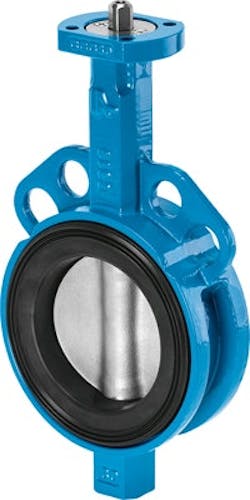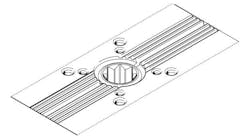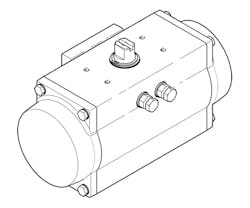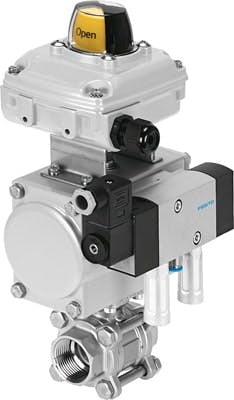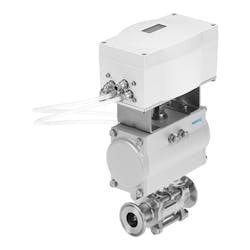About the author: Matt Glicksman is product manager for process automation for Festo. Glicksman can be reached at [email protected] or 925.454.6547.
Ball and butterfly valves receive their names from the insolating element in each valve that controls the flow of media.
Process valve automation is a crucial component of process control. The water and wastewater treatment industry is driven by improved efficiency and cost reduction considerations, so running a system purely through manual operation is no longer cost-effective, safe or reliable. Due to the size of water treatment facilities, valves typically are not within proximity to each other, either being in different areas and levels of the plant, or completely out of human reach. It is important to understand which components to select and why.
Butterfly valves are some of the most prevalent process valves found in water applications. Because the water typically is transported through large pipes and controlled at low pressures and ambient temperatures, butterfly valves are a cost-effective solution when the water is not contaminated with solids. The valve operates by rotating a metal disk that sits in the middle of the pipeline. When the disk is parallel to the pipe, the water can flow freely. Turning the valve 90 degrees makes the disk perpendicular to the pipe and blocks the water. For smaller systems (for example, pipes less than 2 in. in dia-meter), ball valves are a more cost-effective alternative. Ball valves operate with a similar quarter-turn motion, except instead of a metal disk, they use a metal sphere with a bore drilled through it.
Torque Rating
While choosing between a ball or butterfly valve involves more than a few considerations (such as pipe size, media type/pressure and valve cost), the steps for automating them are the same. The most critical detail when building an assembly is the torque rating. Proper sizing ensures that the actuator will be strong enough to operate the process valve when needed. Determining an accurate torque rating begins with the breakaway torque (also known as unseating torque). This is the rotational force required to open the valve from a fully closed position and is higher than running or action torque, the force needed at any other position.
It is important to note that media pressure can affect torque requirements. Valve suppliers typically offer breakaway torque relative to the nominal pressure of the valve. In the case of butterfly valves and large ball valves, breakaway torques are given relative to reduced media pressures to help properly size the actuator to the application.
Safety Factor
Once the breakaway torque is determined, the next step is to increase this value by applying a safety factor. A valve supplier will sometimes give the torque rating with a safety factor already included, but unless clearly stated, never assume that this is the case. Alternatively, vendors may supply a safety factor table as a reference. If no safety factors are provided, the information below may be used as a guideline. By selecting the appropriate factor from each step and adding them together, a cumulative safety factor can be calculated and applied to the breakaway torque. For example, in an application where water is being proportionally controlled, the stated breakaway torque should be increased by 40% (safety factor of 20% + 20% = 40%).
- Type of Media
- Wet or lubricating applications – 20%
- Dry gas or steam applications – 30%
- Viscous or abrasive applications – 50%
- Type of Operation
- On-off applications – no additional factor
- Proportional applications – 20%
- Frequency of Operation
- Daily – no additional factor
- Weekly – 30%
- Monthly – 50%
Once the safety factor is incorporated into the torque rating of the valve, the next step is selecting a pneumatic actuator to control the valve. There are two types: double acting and single acting. A double-acting actuator requires air to open and close the valve. If there is a loss of air pressure at any point, the valve will hold its last position. A single-acting actuator uses air to rotate in one direction and a set of springs to move in the opposite direction. Whether the springs are used to open or close the valve depends on how the valve and actuator are assembled. This is also the fail position when air pressure is lost.
Sizing the actuator depends on the available air pressure. The lower the pilot pressure, the larger the size required. The actuator’s torque rating must be greater than or equal to the final valve torque calculated for the application. For ease of automation, ball and butterfly valves should have a direct mount pad so that the two components can be assembled without a mounting kit. Most valve and actuator suppliers use the ISO 5211 interface standard, which consists of a bolt pattern and square stem for simple assembly. Without this standard, valve assemblies would require a mounting bracket and stem coupler that are not only expensive, but also space consuming, increasing the overall height.
For the greatest flexibility, many valves and actuators come with more than one flange pattern when permissible. The flange pattern of the process valve and selected actuator must always be compared. Because the ISO 5211 interface standard is based on specific torque ranges, the two components will likely have a matching bolt pattern. If the actuator’s flange pattern is smaller than the valve’s, the actuator can be upsized to achieve a match.
Industrial ball valve assembly with pneumatic actuator, NAMUR pilot valve and sensor box
Size Comparison
The final piece of the puzzle is the size comparison between the valve’s square stem and the actuator’s shaft. Again, due to the interface standard following certain torque ranges, it is possible that the components perfectly mate. However, for flexibility, the actuator shaft may be a size larger than the valve’s stem. In this case, a simple reducing sleeve can be used to increase valve stem size and match the actuator’s shaft.
Process valves are used across many stages in water treatment, including utility lines, filtration, treatment and distribution. Automation of these valves is a simple way to improve efficiency and lower the cost of operation in the water and wastewater industry.
Sanitary ball valve assembly with pneumatic actuator and digital positioner
